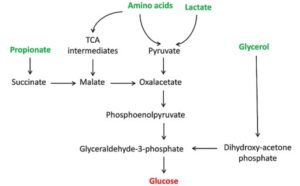Introduction
Different strategies have been evaluated in order to mitigate the negative energy balance during early lactation. Some of these include use of oral drenches and pastes to feed glucose precursors such as calcium propionate, propylene glycol or liquid glycerine, to minimise ketosis disease and the associated fresh-cow metabolic disorders. Such interventions may work but their effectiveness is often transient if not limited. Furthermore drenching the animals to deliver the glucose precursors involves restraining which at times require specialised personnel
Limitations of liquid therapies
Glucose substrates added in liquid form directly to the rumen have limitations in alleviating the symptoms of ketosis. Firstly, they undergo rapid microbial fermentation and lower rumen pH with a number of consequences. These include risk of rumen acidosis, depressed fibre digestion, drop in milk fat and reduced dry matter intake. Secondly, there is a shift in the pattern of volatile fatty acid production with increased yield of butyric acid which overloads liver further with more ketone bodies thus exacerbating the fatty liver-ketosis complex
Rumen protected glycerine
UFAC UK have developed a unique process of protecting glycerine inside the matrix of fine particles of vegetable fibre that ensures the glucose precursor escapes rumen fermentation, is slowly released, gets absorbed in the small intestine and delivered directly to the liver for the production of glucose. Glycerol is a more effective treatment against ketosis in dairy cows when administered in this manner. It enters the metabolic pathway to glucose in a different location than other glucogenic precursors and as such is more beneficial to the cow.
Metabolism of Glycerol
- Glycerol enters the gluconeogenic pathway at the triose phosphate level and is therefore more metabolically efficient than propionate (Hippen et al., 2008) (see figure below). This is because propionate goes through 6 steps to convert to glucose while glycerol passes through 3 stages only to reach glucose.
- Liquid glycerol fed to ruminants is largely fermented in the rumen with the remainder either absorbed across the rumen epithelium or escapes the rumen by outflow through the omasal orifice.
Most of the glycerol fed as liquid is rumen fermented into propionate and is therefore less efficiently converted into glucose
Visible performance
Several on-farm trials have demonstrated consistently that cows fed UFAC UK glycerene from 21 days prepurtum and well into early lactation exhibit optimal dry matter intake, more positive energy balance, improved health and lactational performance.

In West Wales, a well-managed dairy herd of 250 holstein-friesian cows with a rolling annual average of 11,000 litres and calving interval of 405 days, glycerene was fed from three weeks pre-calving to 21 days into lactation. Herd performance was as follows:
Cow health status
| Control group | glycerene group | |||
| Parameter | Dry | Lactating | Dry | Lactating |
| BCS | 3 | 2 | 3.1 | 2.4 |
| NEFA (mmol/l) | 0.3 | 0.3 | 0.3 | 0.3 |
| BHB (mmol/l) | 0.6 | 1.1 | 0.6 | 0.9 |
Effect of glycerene on cow performance
| Control group | glycerene group | |
| Days in milk | 14 | 23 |
| Milk yield (litres/day) | 35 | 37.8 |
| Milk fat (%) | 4.15 | 4.15 |
| Milk protein | 3.28 | 3.28 |
| Change in NEFA | 0 | 0 |
| Change in BHB | 0.5 | 0.3 |
| Change in BCS | -1 | -0.7 |
| Daily liveweight change (kg) | -2.06 | -1.16 |
According to Cornell definition, cows with NEFAs above 0.7mmol/l and BHB of more than 1.0 mmol/l in early lactation have increased risk of post-calving diseases (displaced abomasum, metritis/retained placenta and clinical ketosis), decreased milk yield and reduced reproductive performance in the first 30 days in milk. Recent studies at Royal School of Veterinary Studies in Edinburgh, UK confirmed these relationships between the blood parameters and risk factors in cow health.
Despite the high level of management at the farm glycerene was still effective in maintaining the BHB concentration in the blood below the threshold level and improved herd performance.
Tangible benefits
Feeding glycerene to transition cows clearly has a number of benefits:
- Minimises loss of body condition
- Increases milk production
- Supports rumen stability
- Enhances dry matter intake
- Inhibits mould growth and mycotoxin production
- Overall glycerene is effective in supplying glucose to the liver and reducing body fat mobilisation with attendant benefits of improved cow health and productivity.
Feeding your cows UFAC UK glycerene makes all the difference.
Ref:
Arnold R. Hippen, Jeffrey M DeFrain , and Peter L. Linke (2008). Glycerol and Other Energy Sources for Metabolism and Production of Transition Dairy Cows. Florida Ruminant Nutrition Symposium • Best Western Gateway Grand • Gainesville, FL.
For further information please contact our technical department on 01780460327 or technical@ufacuk.com


 Back to Resources
Back to Resources 